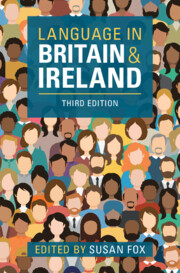Book contents
- Language in Britain and Ireland
- Language in Britain and Ireland
- Copyright page
- Contents
- Figures
- Tables
- Contributors
- Acknowledgements
- Map of Britain and Ireland
- Introduction
- Part I English
- Part II Multilingualism in Britain and Ireland: The Celtic Languages
- Part III Multilingualism in Britain and Ireland: Minority Languages
- 15 Channel Islands French
- 16 South Asian Languages
- 17 Chinese
- 18 Yiddish
- 19 European Immigrant Languages
- 20 Sign Languages in Britain and Ireland
- Part IV Multilingualism: The Development of Urban Contact Varieties
- Part V Applied Sociolinguistic Issues
- Index
- References
19 - European Immigrant Languages
from Part III - Multilingualism in Britain and Ireland: Minority Languages
Published online by Cambridge University Press: 17 October 2024
- Language in Britain and Ireland
- Language in Britain and Ireland
- Copyright page
- Contents
- Figures
- Tables
- Contributors
- Acknowledgements
- Map of Britain and Ireland
- Introduction
- Part I English
- Part II Multilingualism in Britain and Ireland: The Celtic Languages
- Part III Multilingualism in Britain and Ireland: Minority Languages
- 15 Channel Islands French
- 16 South Asian Languages
- 17 Chinese
- 18 Yiddish
- 19 European Immigrant Languages
- 20 Sign Languages in Britain and Ireland
- Part IV Multilingualism: The Development of Urban Contact Varieties
- Part V Applied Sociolinguistic Issues
- Index
- References
Summary
This chapter charts the European aspect of the linguistic mosaic of Britain and Ireland drawing on data from the 2011 and 2021 censuses as well as data from the UK’s EU Settlement Scheme. It offers a critical assessment of the practices that statistical authorities adopted for publishing language data they collected by means of the censuses, showing that the aggregation of respondents’ write-in responses into so-called ‘main language group classifications’ and ‘table categories’ led to a significant under-reporting of the number of languages spoken in Britain and Ireland including languages classified as European. It further presents arguments that have been raised by linguists regarding the phrasing of the language question in census questionnaires and suggests new sources of statistical information that could be used in conjunction with census data in order to obtain a fuller picture of European multilingualism in the British Isles. It finally takes issue with the labelling of particular languages as ‘European’ based on essentialist and hierarchising assumptions about the links between language, ethnicity, nationality, ancestry and identity, arguing that all languages that are spoken by citizens who identify as European should be considered European languages.
Keywords
- Type
- Chapter
- Information
- Language in Britain and Ireland , pp. 425 - 438Publisher: Cambridge University PressPrint publication year: 2024

